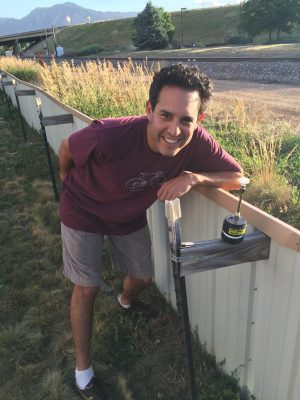How can we assess health risks from air pollution?
October 15, 2017
William Vizuete, PhD
Associate professor of environmental sciences and engineering
Today, we regulate air quality as if humans are exposed to each air pollutant separately. In real life, though, we take in a mixture of these gases and particles every time we breathe. My work, and that of many others, attempts to determine the health impacts of the mixture of pollutants, as opposed to individual pollutants, and to establish whether our current air quality standards truly protect human health.
The composition of particles changes in the atmosphere. Work from my laboratory has shown that the composition influences the toxicity of particles. Right now, we base air-quality regulations solely upon the mass of particles in the air; regulations do not take into account the composition of particles. This means that two particles of equal mass have differing toxicities based upon their composition – but federal regulations categorize them as equal. We need more research to determine whether we can develop smarter regulations.

Q: Are there other emission sources that become toxic when they interact with the sun and atmosphere?
A: A leading cause of death from air pollution is exposure to tiny particles in the atmosphere. These particles are so small that, when breathed in, they become deposited deep in the lungs. The particles consist of many different types of chemical species, some of which are created when gases interact with the sun.
Recently, scientists, including Dr. Jason Surratt, associate professor of environmental sciences and engineering at the Gillings School, have discovered a new source of these particles – from gases that are emitted by plants. This is an exciting discovery. Right now, my work is focused on understanding the chemistry that leads to the formation of these particles and makes them toxic. Our recent work has shown that particles formed from these emitted gases cause increases in toxicity, as measured by exposing them to human lung cells (outside the human, of course).
Q: Tell us more about your work.

Dr. Will Vizuete prepares to take air samples in Boulder, Colorado. (Photo by Chitsan Wang)
A: More than 4.5 million people die each year from air pollution-related causes. That’s way too many. As a chemical engineer, I wanted to find a way to help reduce this number. I began work to improve air-quality models that simulate the environment. If we can develop models that accurately mimic the real atmosphere today, we can use them to predict the atmosphere a few days from now, a few months from now or even many years from now. These predictions can help guide policy decisions that will make a real impact on air quality. We can use these models to predict, for instance, the effect cleaner power plants or cleaner cars would have on our air quality.
Air quality models being used by scientists now are better than they have ever been. Still, they don’t simulate air quality as accurately as they might.
My team works with the U.S. Environmental Protection Agency and others to incorporate into the models the latest scientific discoveries about how air pollution is formed. This is trickier than it may appear, as the models and the air chemistry we are studying are so complex. Each time we modify one part of the model, we must consider the effect that change will have on the rest of the model. We work with chemists and other engineers to evaluate the model predictions against data collected in the field to determine how close they are to reality.
The models we create ultimately help guide decisions made by state and federal regulatory agencies to protect the public’s health.
Carolina Public Health is a publication of the University of North Carolina at Chapel Hill Gillings School of Global Public Health. To view previous issues, please visit sph.unc.edu/cph.
